
Camping In Tayrona National Park
The warm salty air swept across my face as I watched the sunrise over the calm Caribbean Ocean. I was in the heart of Colombia’s northern coast camping in Tayrona National Park and I couldn’t imagine how my day could possibly get any better.
This post is in large part an adventure story of my time in Tayrona National Park. If you are researching camping there solely to find out the logistics, but don’t want to see any photos, scroll down to the bottom of the post where I have listed the total cost, the many ways to get there, as well as what to pack.
Reader Beware: Tayrona National Park is a stunning work of nature. So I dare you not to get curious.
Tayrona National Park
El Parque Nacional de Tayrona lies along Colombia’s northern Caribbean coast and is one of the most well-preserved parks that I’ve encountered in Latin America. The park consists of 12 square miles of maritime area and 58 square miles of dense jungle. It is incredibly biodiverse with around 770 species of plants and is home to over 400 species of animals.
Archaeological evidence has shown that there were ancient settlements up until the 16th century. The current inhabitants of the park the Kogi (Jaguar in the Kogi language) can be seen all throughout the park wearing white cloth garments and usually carrying large bundles hung from their forehead.
It is a must see if you are in the northern part of Colombia. I haven’t come across a single traveler who was not planning a visit or who hadn’t already been.
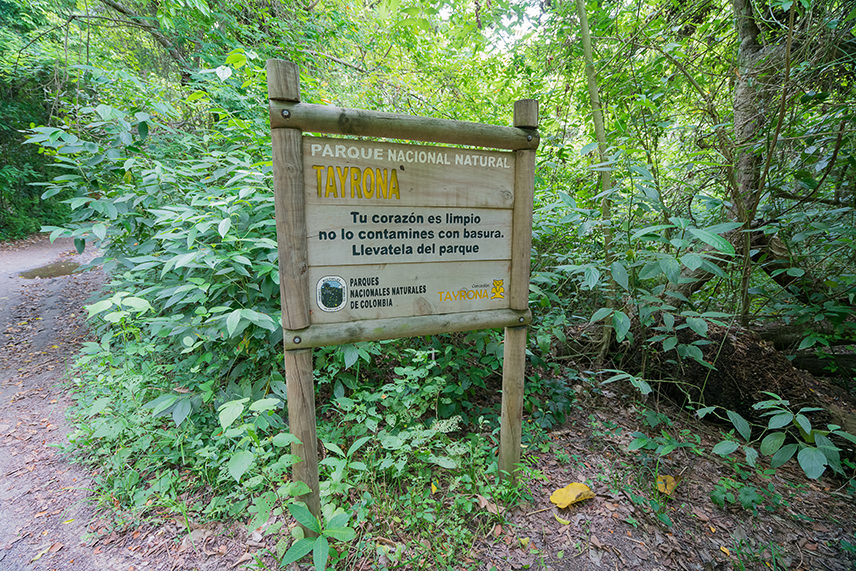
Welcome To Tayrona
The trail wastes no time in throwing you deep into the elements. After passing the welcome sign the trail quickly turns into some wildly overgrown jungle.
Nicely constructed wood platforms lead you over the densely vegetated jungle floor, climbing around large boulders and ducking under tree trunks that seem to grow in which ever way they please. It was a nice mixture of comfortable walking while still keeping the rawness of the jungle intact.

The Dense Jungle Trail
The trail goes on like this for about half an hour while the sounds of the jungle completely surround you. Monkeys rustling the leaves as they chase after birds jumping from tree to tree and an army of ants completely covering a log; most likely carrying back building supplies and dinner for the queen. There is so much life happening if you just stop to notice.
Be sure to watch your step!

God Save The Queen
After being drenched in sweat and constantly fending off the hoards of mosquitos for what seems like an eternity, you will slowly start to notice a different sound. Something you have not yet heard. Something entirely new.
It starts as a faint white noise that you think might be locust, but in the middle of the day? As you continue on, the white noise turns into a dull steady roar and then all of a sudden you can see a break in the trees. Through the opening. A bright turquoise wall of water.

First View Of The Ocean
The sounds of the jungle start to fade away as pulsating waves crash into the shore one by one growing louder and louder. A slow salty breeze brings much-needed relief from the stagnant jungle heat.
The excitement starts to build as the trees on your horizon become fewer and far between until the jungle of Tayrona decides to finally reveal its first breathtaking view of the trek.

The Beaches of Tayrona National Park
I couldn’t believe my eyes. A Long deserted beach with no tourists or trash.
Was I still in Latin America?
I know that sounds terrible but the proof is in the pudding. Most beaches in this part of the world that are frequented are usually lined with garbage. Either brought in by people or the rolling tides. I guess you can take this as my way of trying to spread a word of change.
My pace quickened as I made my way down through the massive sandstone boulders that had been carved by millions of years of salty sea air.

Walking Through Time
As I turned the corner the trail suddenly dropped off into some very ominous looking mangrove. I had one of those moments that I am sure many of you have experienced, where you look around and think surely I’m missing the real trail.
Right?
With reckless abandon, I threw my childhood teachings out the door and walked into the dark scary looking bushes all alone.
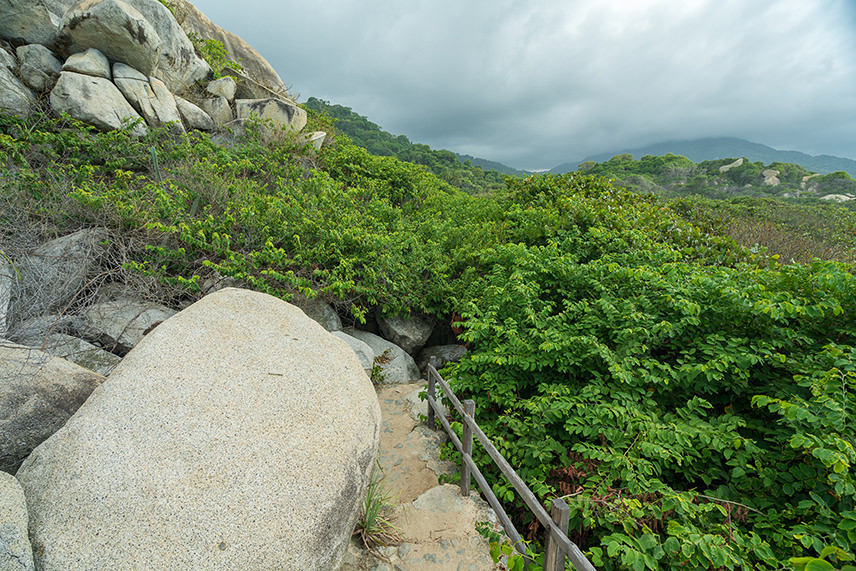
Walking Into The Unknown
I don’t know what I was expecting to find down there. Maybe a path so dense and swampy you needed a machete to get through. I guess my hope for some crazy adventure took over and I forgot all about the nicely maintained trail I had been hiking up until this point.

These Bushes Aren’t So Scary
It was actually the nicest I could imagine a path through mangroves could possibly be. A dry flat surface only partially blocked by an occasional rogue limb.
Once through, the trail carries on along the beach for few minutes and then leads you into a very swampy marsh. Luckily the maintainers of the park have again generously provided a walkway just inches above to uncomplicate things.
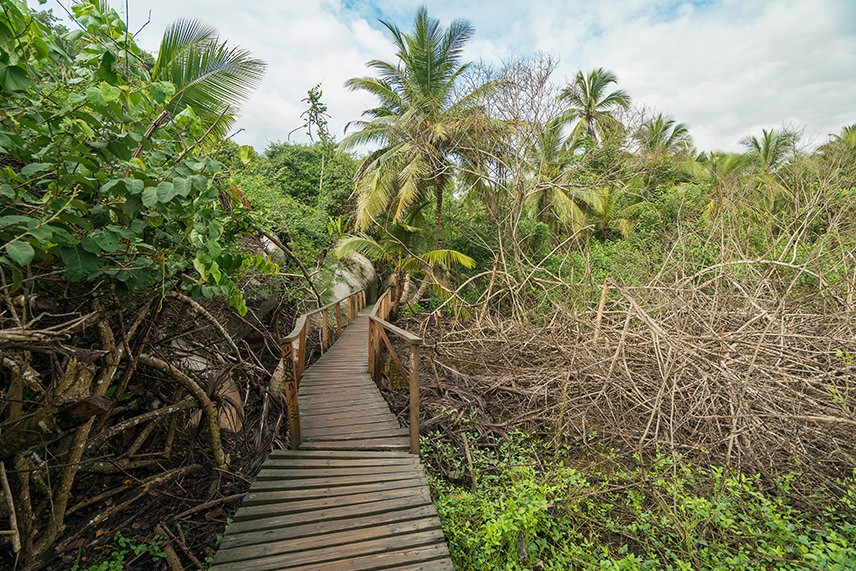
Walking Inches Above The Marsh
After the sphincter clinching, sweaty palmed, death defying experience of walking inches above what would certainly mean muddy feet, you will arrive at the first area for camping in Tayrona National Park.
A small area named Arrecifes. It’s not much more than a few restaurants and high-end glamping. It is however much less crowded than the more popular Cabo San Juan.
Advisory: Many of the camping areas in Arrecifes such as Bucarú and Jorge Andres are currently closed for reforestation. From what I could see the land looked abused and many of the trees had died. Be sure to leave plenty of time to hike the extra hour to Cabo if things don’t work out.
The trail leaving Arrecifes is quite muddy and laden with droppings from constant horse traffic. After an afternoon rain shower, many of the small streams become not so small. Be prepared to de-shoe or just switch to sandals for the remainder of the trek.

Small Streams Become Big Streams
One of the reasons I loved Tayrona National Park so much was the option to choose more than just one path. Being that you have to hike out to the same entrance you came in. It makes it much more interesting to make the trail a loop instead of retracing your steps.
These options come by way of the old time classic fork in the road.

Hmmm….Which Way To Go?
When headed West into the park a fork in the road can be interpreted as going left for more dense jungle and going right for the cool breeze of the beautiful Caribbean coastline.
Being 4 o’clock in the afternoon and sweltering hot as I came upon this quandary, I obviously opted for the coast. I would not be disappointed in the least.
I highly recommend taking the coastline route either on the way in or on your return trek out of the park. You will of course find more beaches perfectly contrasted with the turquoise water, soft yellow sand, and bright green tree line, although, this time more inhabited than before.
It isn’t all sand and coconuts though. Along the route are quite a few lagoons with massive sea worn boulders perfectly reflected in the still waters.
There are even alligators, which I was more than glad not to encounter.
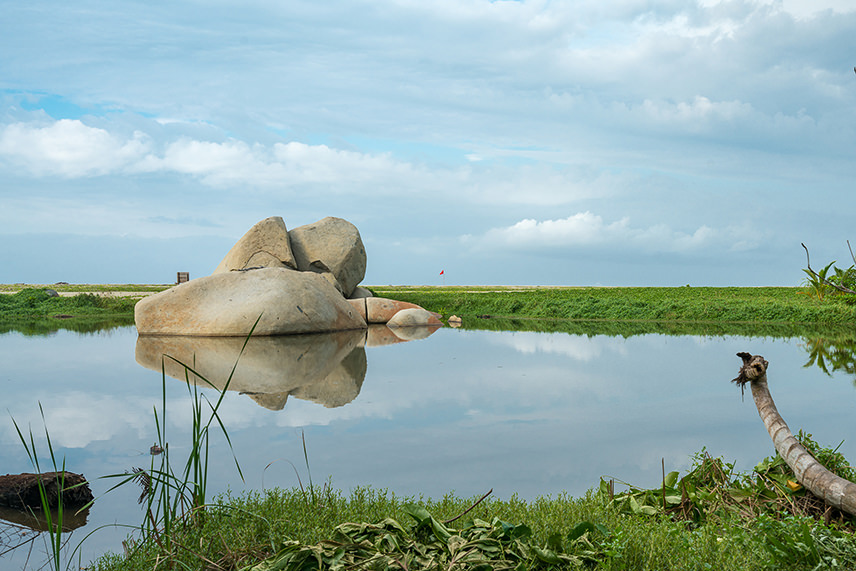
More Than Just Sandy Beaches
The sun was hanging really low in the sky as my watch struck half past five. If it wasn’t for my favorite offline map app Maps.me, I would have been worried that I wasn’t going to make it to camp before dark. However, the map showed me being only about ten minutes out.
So I made my way back into the jungle, all the while keeping a close eye on the sky. Just when I was about fed up with the heat, the sun started to breach through the trees and a clearing was visible in the distance. I had made it and I couldn’t have arrived at a better time of day.
Welcome To Cabo San Juan
The sun was casting a perfect light on the campground as well as the screaming Colombian man being thrown to the ground by two police officers. For what I haven’t a clue. No doubt a very interesting introduction to Cabo San Juan.

Cabo San Juan Campgrounds
I quickly paid the $7 to hang my own hammock and made my way to camp. Trying not to become part of the exciting scene unfolding right in front of me.
The normal price for renting a tent or hammock is $9 per night.
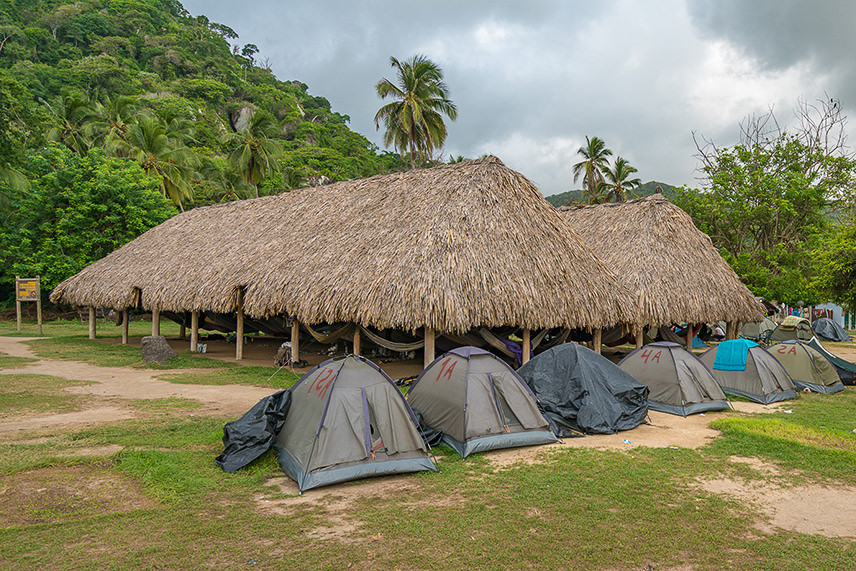
The Very Cramped Hammock Hut
When planning to go camping in Tayrona National Park, one thing to consider is of course how you want to spend the night. Do you prefer to sleep in a tent or does floating above the cold hard earth sound more enticing?
There are ups and downs to both at Cabo San Juan campground. If you choose the tent you will have your own space but are subject to the common heavy downpour during the night. If you swing more towards a hammock (pun intended) you get the shelter of a palapa but are going to be shoulder to shoulder with strangers inside the very cramped hammock hut.
When you are staying in Tayrona there is not much to do past dark. That is unless you like to drink excessively. I recommend foregoing the drinks and waking up early for sunrise overlooking the Caribbean.
Trust me it’s totally worth it.

A Beautiful Caribbean Sunrise
After you’ve had your fill it might not be a bad idea to take yourself a small nap as the sun starts heating the air and the water to near perfect beach weather.
Around 9 o’clock is the perfect time to grab some breakfast and head off to explore the other beaches just beyond Cabo.
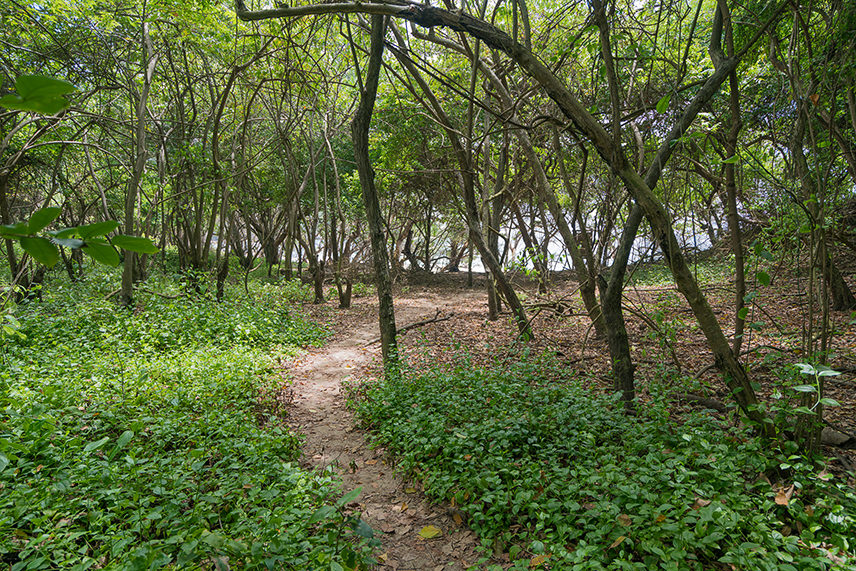
Only A Short Walk To The Beach
The beaches directly in front of the campground, while absolutely beautiful, are packed full of the hundreds of other campers. If you fancy yourself some tranquility, the beaches surrounding Cabo are mostly empty. Apparently, most campers prefer not to walk the ten minutes to have a piece of beach pie all to themselves. I guess that just means more for you.
Nudist Alert: The beaches that lie just beyond the campground are nudist friendly. So if the naked human body offends you, maybe don’t look too closely at the other beach goers.
The short trek is completely worth the little bit of sweat required. The beaches are mostly deserted and the water is perfect all except for the rough tide.

More Empty Beaches
Another great thing about spending more than just one day camping in Tayrona National Park is the ability to truly relax. There isn’t much more to do than hang out at the beach. So just chill out and enjoy the beautiful nature surrounding you.
Around midday is a great time to head back for some grub. If you are a little more daring than most and love snapping photos that not many others take the time to capture, then I would try scaling the large boulders along the coast on your way back to camp. It makes for a unique angle of Cabo and it’s a bit of an adrenaline rush as well.

Capture A Unique Angle Of Cabo San Juan

The Jungle Comes To Life
My walk back was through the jungle and I wouldn’t trade it for anything. I decided to take off in the morning and the jungle looks entirely different in the morning. The animals are just waking up, the birds are singing to each other, and water left from the storm the night before was steaming off the jungle floor.
It is one of my favorite memories of Colombia.
Tayrona Costs And Directions
Transportation
There are more than a few ways of traveling to Tayrona National Park. Below are just a few of the most popular.
Fees and Food
So you have passed the main entry point and had your things rifled through by the police. Now it’s time to make it rain cash.
Tayrona National Park Entry Fee – I have heard the price varies from time to time based on projects they have going on in the park. The price I paid in July of 2017 was 48,000 pesos or $16 USD.
The main entrance to Cañaveral – The main entrance is actually quite far from the trail head. Colectivos will be lined up ready to take you to the start of the trek. The cost should be 4000 pesos or $0.99 USD.
Camping with your own gear – Laying down a tent or hanging your own hammock will set you back 20,000 pesos per night or $7 USD.
Renting a Camping Spot – If you need to rent a tent or hammock it will set you back 25,000 pesos per night or $9 USD.
Food Prices – The meals in Tayrona are a bit extreme for being not that far away from civilization. Meals range from 10,000 – 40,000 pesos or $3.40 – 13.50 USD.
Water, Soft Drinks, and Beer – There is a shop next to the dining hall that sells basics like drinks and toiletries. Water and soft drinks will set you back 3,000 pesos or $1 USD and a can of beer should be 5,000 pesos or $1.65 USD.
You can save some money by bringing in your own food and water. I brought a bag of cereal for breakfast. Cookies, granola, and tuna for lunch and dinner. As well as four liters of water. In total, 12,500 pesos or $4.20 USD.
Rules Alert: Make sure to consolidate the things you bring into one bag as the park officials only allow so much outside plastic to be brought in to the park.
What To Pack
Here are all of the items I brought with me for my two-night stay at Cabo San Juan in Tayrona National Park. (This does not include the food and water.)
- Daypack
- Bag Rain Cover
- Hammock or Tent
- Headlamp
- Sunscreen
- Bug Spray
- First Aid Kit
- Camera
- GoPro
- Extra Batteries
- Dry Bag
- Travel Towel
- 3 T-Shirts
- Swim Shorts
- Convertable Hiking Pants
- Pullover (for cold nights)
- Rain Jacket
- Hiking Shoes
- Sandals
- 2 Pairs of Socks
- 2 Pairs of Underwear
- Soap
- Sunglasses
- Travel Pillow
So, what do you think?
Does camping in one of Colombia’s most beautiful Natural Parks excite you?
If you’ve already been, let me know what your favorite part was by leaving a comment below.

